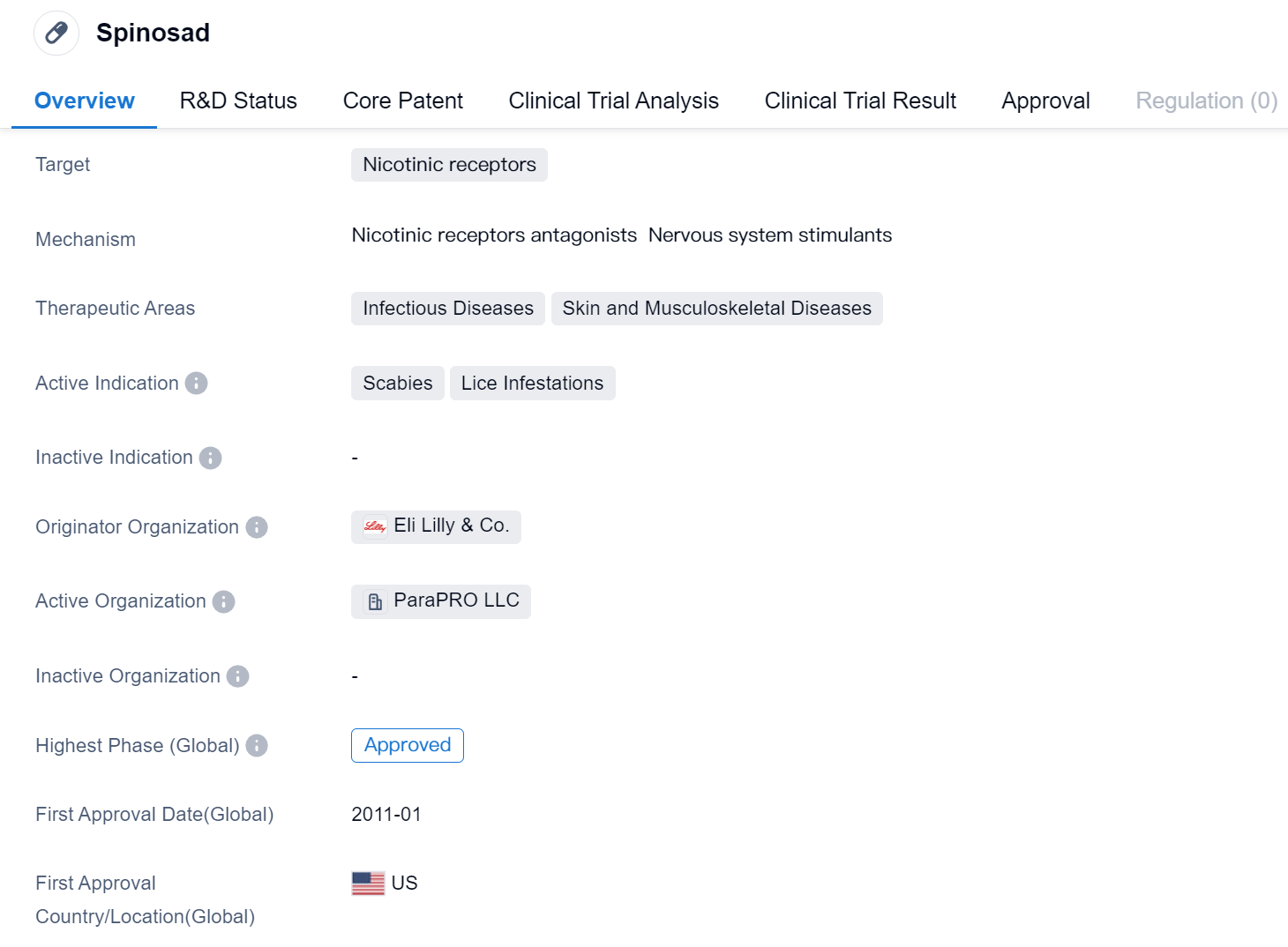Unleashing the Power of Spinosad: A Comprehensive Review on R&D Breakthroughs
Spinosad's R&D Progress
Spinosad is a small molecule drug that targets nicotinic receptors. It is primarily used in the treatment of infectious diseases, as well as skin and musculoskeletal diseases. The active indications for Spinosad include scabies and lice infestations.
The drug was developed by Eli Lilly & Co., a renowned pharmaceutical organization. Spinosad has successfully completed all phases of clinical trials and has received approval for use. The highest R&D phase of Spinosad is approved.
Spinosad was first approved for use in the United States in January 2011. This signifies that it has undergone rigorous evaluation by regulatory authorities and has been deemed safe and effective for use in patients. The approval in the United States suggests that Spinosad has met the necessary standards set by the Food and Drug Administration (FDA) for pharmaceutical products.
The therapeutic areas targeted by Spinosad, infectious diseases, and skin and musculoskeletal diseases, highlight its potential in addressing a wide range of medical conditions. Infectious diseases, such as scabies and lice infestations, can be highly prevalent and pose significant health risks. By targeting nicotinic receptors, Spinosad aims to effectively combat these diseases and provide relief to patients.
The approval of Spinosad in 2011 marked a significant milestone in the pharmaceutical industry. It demonstrated the successful development and evaluation of a small molecule drug targeting nicotinic receptors. The approval in the United States further solidifies its credibility and potential for global use.
👇Please click on the image below to directly access the latest data (R&D Status | Core Patent | Clinical Trial | Approval status in Global countries) of this drug.
Mechanism of Action for Spinosad: Nicotinic receptors antagonists Nervous system stimulants
Nicotinic receptors antagonists are a class of drugs that block or inhibit the action of nicotinic receptors in the body. Nicotinic receptors are a type of receptor found in the nervous system that bind to the neurotransmitter acetylcholine. By antagonizing these receptors, the drugs prevent acetylcholine from binding and exerting its effects.
From a biomedical perspective, nicotinic receptor antagonists can have various applications in the field of biomedicine. For example, they can be used as muscle relaxants during surgical procedures or as treatments for certain neurological conditions such as Alzheimer's disease or Parkinson's disease. By blocking the action of nicotinic receptors, these drugs can help regulate the transmission of nerve signals and alleviate symptoms associated with these conditions.
On the other hand, nervous system stimulants are a different class of drugs that have the opposite effect. They enhance or increase the activity of the nervous system, leading to increased alertness, wakefulness, and cognitive function. Nervous system stimulants can act on various neurotransmitters in the brain, such as dopamine, norepinephrine, and serotonin, to promote increased neuronal activity.
In a biomedical context, nervous system stimulants can be used to treat medical conditions such as attention deficit hyperactivity disorder (ADHD), narcolepsy, and certain forms of depression. These drugs help improve focus, attention, and wakefulness in individuals with ADHD or narcolepsy. They can also alleviate symptoms of depression by increasing the levels of certain neurotransmitters involved in mood regulation.
Overall, nicotinic receptor antagonists and nervous system stimulants are two different classes of drugs that have distinct effects on the nervous system. While nicotinic receptor antagonists inhibit the action of nicotinic receptors, nervous system stimulants enhance the activity of the nervous system. Both classes of drugs have important biomedical applications and can be used to treat various medical conditions.
Drug Target R&D Trends for Spinosad
Nicotinic receptors are a type of neurotransmitter receptor found in the human body. They are primarily located in the central nervous system and peripheral nervous system. These receptors are activated by the neurotransmitter acetylcholine and play a crucial role in various physiological processes. Nicotinic receptors are involved in muscle contraction, cognition, memory, and attention. They also have implications in addiction, as they are the primary target of nicotine in tobacco products. Understanding the function and regulation of nicotinic receptors is important for developing therapeutic interventions for conditions such as Alzheimer's disease, Parkinson's disease, and nicotine addiction.
According to Patsnap Synapse, as of 7 Sep 2023, there are a total of 170 Nicotinic receptors drugs worldwide, from 159 organizations, covering 91 indications, and conducting 1492 clinical trials.
👇Please click on the picture link below for free registration or log in directly if you have a freemium account, you can browse the latest research progress on drugs, indications, organizations, clinical trials, clinical results, and drug patents related to this target
Conclusion
In conclusion, Spinosad is a small molecule drug developed by Eli Lilly & Co. It targets nicotinic receptors and is primarily used in the treatment of infectious diseases, as well as skin and musculoskeletal diseases. With its approval in the United States in 2011, Spinosad become a valuable addition to the pharmaceutical industry's arsenal.






